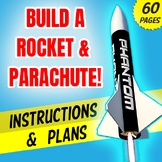417 results
Biology simulation microsofts
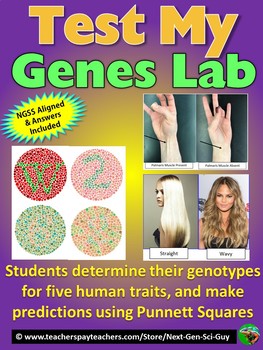
Test My Genes Lab: Students Use Their Traits to Practice Punnett Squares - NGSS
In Brief: The lab proceeds as follows1. Students complete a short matching section using important genetics terms2. Students read about five different human traits (Interlacing of fingers, PTC tasting, Presence of Palmaris Longus Muscle, Hair Texture, and Color Vision)3. Students attempt to determine their genotpyes, based upon their phenotypes, and the information in the lab.4. Students perform Punnett Squares using their genotypes, in order to make predictions about future generationsA. NEXT
Subjects:
Grades:
7th - 12th

Virtual Human Brain Dissection
This is a virtual dissection alternative that allows students to dissect a 3D human brain, record observations, answer analysis questions on the observations and label a sheep's brain with the synonymous human brain structures. The analysis questions are mixed formats between direct questions and critical thinking concluding questions. This activity can be completed completely online or printed out for in-person instruction. It is meant to serve as an alternative method to performing a dissectio
Subjects:
Grades:
9th - 12th, Higher Education
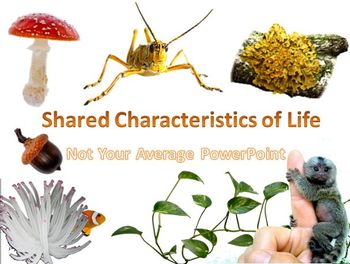
Characteristics of Living Things Interactive PowerPoint AND Case Studies
Fun, animated review of the material as well as TWO case studies exploring the characteristics of life. Students journey to Europa, where they must analyze samples for the presence of life. In the second case study, students discover the tobacco mosaic virus.
This extremely fun PowerPoint was created to get kids thinking! No more simple lectures centered around listing the shared characteristics of life - your students will be putting themselves in the shoes of xenobiologists and research bota
Subjects:
Grades:
7th - 12th
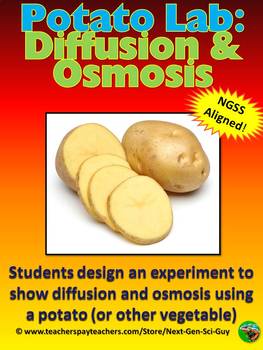
Potato Lab: Diffusion and Osmosis - NGSS
A. NEXT GENERATION SCIENCE STANDARDS HEREIN
DCI’s: LS1.A Structure and Function
Cross Cutting Concepts: Cause and Effect, Systems and System Models, Stability and Change
Scientific and Engineering Practices:
Asking Questions and Defining Problems
Analyzing and Interpreting Data
Developing and Using Models
Constructing Explanations and Designing Solutions
Engaging in Argument from Evidence
Obtaining, Evaluating, and Communicating Information
B. SUGGESTED USES
Prior Knowledge: Stud
Subjects:
Grades:
7th - 12th
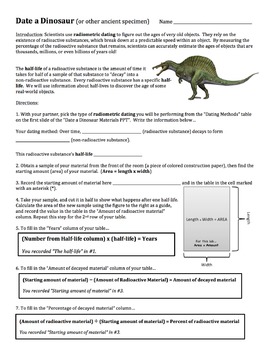
Date a Dinosaur Half-Life Activity
This activity allows students to work with the concepts of radioactive decay as it pertains to radiometric dating. Students use construction paper to model the radioactive decay of various substances, ultimately creating a graph that they use to date a variety of prehistoric specimens. This zip file includes 1. Teacher Directions Sheet, 2. Student Sheet, 3. PowerPoint
Subjects:
Grades:
7th - 9th

Forensic DNA Fingerprinting Webquest
PRODUCT UPDATED 11/2/18"A perfect combination of interactive technology and reinforcement of key concepts."Bring your forensic science classroom to life with this interactive webquest!This Cornell-style webquest consists of 43 teacher made questions that go along with a variety of websites on DNA, including simulations on extracting DNA and running a gel electrophoresis with questions that go with each. My students absolutely loved learning all of the steps of running their very own gel electr
Subjects:
Grades:
8th - 12th
Types:
Also included in: HUGE Forensic Science Bundle
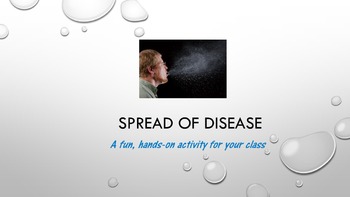
Patient Zero - Spread of Infectious Diseases
* Fun experiment that let students to visualize the spread of disease in a class population
* Materials required for this experiment are simple and non-hazardous
* Students in small groups can work together and use their problem solving skills to identify “Patient Zero” – the original person carrying the disease
*A great activity to lead into other topics. Depending on class level, follow up topics could include: public health initiatives, virus, flu season, tuberculosis, STD, HIV/AIDS, etc
Grades:
9th - 12th
Types:

Crime Scene DNA Fingerprinting Lab with Key for Bar Codes
This is one of my favorite activities! The students really have a lot of fun with this lesson. After a brief talk about how the DNA in each of us is different, I relate that to how each food item has a different bar code as well. I use bar codes (DNA samples) and place them around my room on various objects. The students have to match the DNA sample (bar code) with the bar codes on their paper to see which perpetrator was at that particular crime scene. You can change the names on the bar code s
Subjects:
Grades:
4th - 10th
Types:
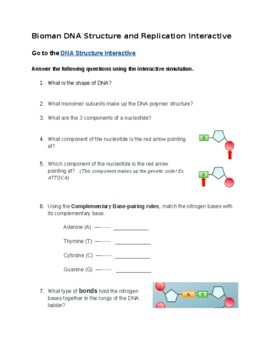
Bioman DNA Structure and Replication Interactive
Students will use the DNA Structure Bioman Interactive to observe the structure of a DNA moleculeStudents will understand the shape and components of a DNA strand.Students will use the DNA Replication Bioman Interactive to observe the steps of DNA Replication and understand the role of various enzymes in the process.Students will observe the semi-conservative nature of DNA replication.
Subjects:
Grades:
8th - 11th
Types:
Also included in: Bioman Interactive Simulation Bundle

DNA on the Floor- General Bio DNA Replication Modeling (Best Seller)
**This got a huge update on 5/31/23.**Several years ago, I found this activity on a teacher’s blog. There were no instructions- just a few pictures of the process- and I created these instructions on my own from there. I’ve since modified the process to work for my classes.I NEVER skip this activity- it helps students have those “lightbulb” moments that make replication click. Understanding the lagging strand can be very challenging, and I find that this activity makes it so much more accessible
Grades:
9th - 12th
Types:

Symbiosis Activity/ Simulation & Limiting Factors
This original activity may be used as an introduction or review of
Symbiotic Relationships and Limiting Factors.
In this activity, students will be paired together with a partner to simulate several types of symbiotic relationships. Organisms (students) will try to fulfill their requirements for life: food, water, living space, and shelter (limiting factors). The scoring system for each symbiotic relationship is different to simulate the benefits and deterrents of each relationship. Points
Subjects:
Grades:
7th - 10th
Types:
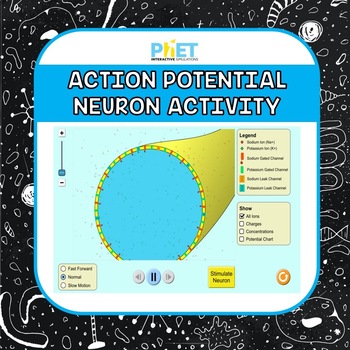
Action Potential Neuron Activity
Using the free PhET simulation, this activity helps guide students through the process of an action potential by focusing on the membrane of a neuron. This lab would be most appropriate for an high school Biology or Anatomy and Physiology course. The directions are geared towards students completing the assignment independently, however this could also be projected on a board and completed as a class too! The document is an editable word doc.
Grades:
9th - 12th

Evolution by Natural Selection Interactive Tutorial
First off, this is NOT a typical PowerPoint that simply lists main idea bullets. This is an interactive tutorial using engaging pictures, animations, and questions that require student input in order to proceed. This tutorial will guide students through the process of evolution by natural selection. The tutorial begins by taking readers through an introduction of Charles Darwin and his voyage on-board the HMS Beagle. Next, the tutorial will guide students thought the principles of natural select
Grades:
6th - 12th

Action Potential Modeling Activity 2024
Understanding the events along a membrane that lead to an action potential can be very confusing for students. I use this interactive hands-on activity as an introduction to what happens. It allows me to be more of a facilitator and help groups work through the concepts, like concentration gradients and the movement of charges. Key to the activity is also provided.
Grades:
11th - 12th, Higher Education

Bioman Cellular Respiration Interactive Simulation Worksheet
Students will use the interactive simulation from the Bioman website (linked in document) to explore the steps of aerobic respiration.The students will answer questions as the simulation guides them through the steps of Glycolysis, the Krebs Cycle, and the Electron Transport Chain.Students will then analyze the chemical equation for cellular respiration and compare it to the equation for photosynthesis
Grades:
9th - 12th
Types:
Also included in: Bioman Interactive Simulation Bundle
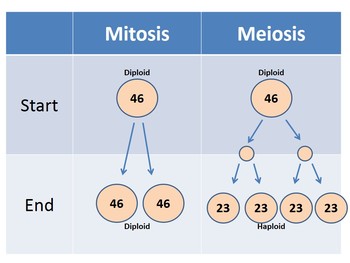
Mitosis vs. Meiosis Animation PowerPoint
The eternal battle of mitosis vs. meiosis comprehension becomes a whole lot easier. In this Mitosis vs. Meiosis animation, the individual stages of mitosis and meiosis are presented together so students can see the subtle differences between each. This is NOT a typical PowerPoint with main idea bullets. This presentation is fully animated so students can visually see the differences and similarities between mitosis and meiosis. Better yet, you can preview the entire PowerPoint on my YouTube chan
Subjects:
Grades:
8th - 12th
Also included in: 20% off bundle: Mitosis and Meiosis
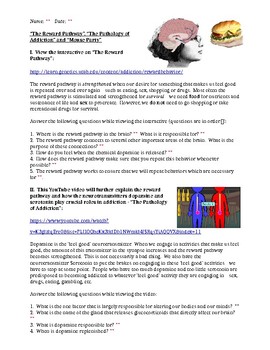
The Reward Path, Pathology of Addiction, Mouse Party Worksheet with KEY
This is a 4-page Word document - the first 2 pages are the assignment, the next two pages are the KEY. I created this assignment to go along with a website and a YouTube video - all awesome, interesting stuff!
The first part of the assignment, "The Reward Path", uses an interactive website at the University of Utah Genetics Learning Center. Students move through interactive and answers questions about the how your brain behaves when it needs something - like food, and eating a cheeseburger.
Subjects:
Grades:
8th - 12th
Types:
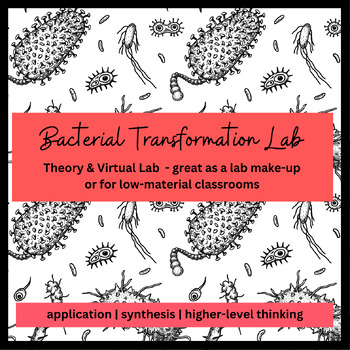
Bacterial Transformation Lab: Theory/Understanding & Virtual Lab AP Biology
As of 2023, I use this as a make-up for students who are absent when we do this lab (we go to a biotech center, so it's impossible for them to make up otherwise. This would also be a great solution if you have limited access to materials.In 2020, this was my solution during COVID to make up this lab.This activity covers the theory behind the AP Bio Bacterial Transformation Lab & includes virtual checks for understanding to assess student knowledge. It's set up for Google Classroom and is ins
Subjects:
Grades:
10th - 12th
Types:
Also included in: The BIG AP Biology Bundle!
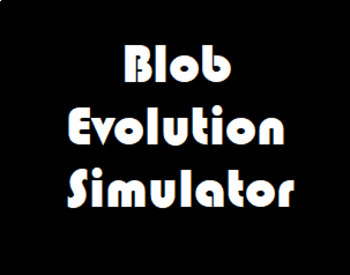
Evolution Simulation by Minute Labs Worksheet Questions / Virtual Lab
Awesome online simulation and videos for evolution. There didn't seem to be any questions available so I made my own. Hope this helps you and your class. It touches upon some basic evolution vocabulary such as natural selection, artificial selection, traits, heritability, mutations, speciation, etc. Designed for about a 60 minute period. Link to the simulation is here if you'd like to check it out: https://labs.minutelabs.io/evolution-simulator/
Subjects:
Grades:
6th - 12th
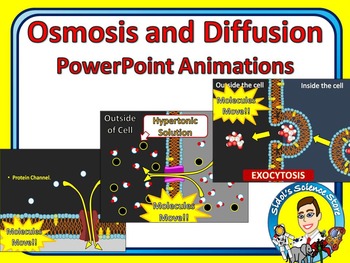
Cell Membrane PowerPoint Animations Full Unit
Included - 28 PPT slides with descriptions and moving objects. Check out the Preview gif!
I have spent hours creating visual animations to incorporate into my PowerPoint presentations. With just the click of a button, students can witness how water molecules move through aquaporins in response to a hypertonic, isotonic, or hypotonic environment; check understanding of solution types and solute movement; Active and Passive Transport of molecules through proteins; Sodium-Potassium Pumps; and End
Subjects:
Grades:
7th - 12th
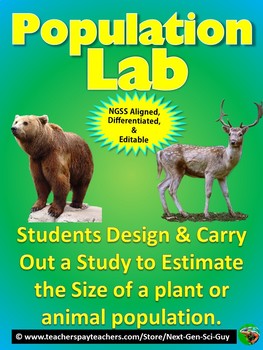
Populations Lab: Design a Study to Estimate the Size of a Population - NGSS
This activity proceeds as follows:1. Students brainstorm about why it is important to estimate the population of organisms2. Students learn how to estimate population using the “sampling” technique3. Students learn how to estimate population using the “mark and recapture” technique4. Students design a study to estimate a real population, and carry out their study.5. Extension Activity: Students read an article about the overfishing of Bluefin tuna, which is down to 4% of the population that it w
Subjects:
Grades:
5th - 12th, Adult Education
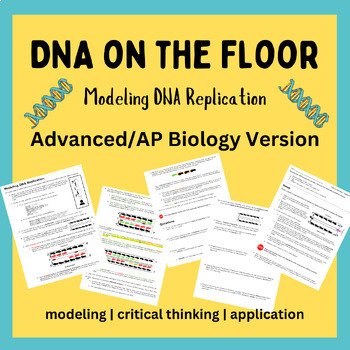
DNA on the Floor- Advanced/AP Bio DNA Replication Modeling (Best Seller)
Several years ago, I found this activity on a teacher’s blog. There were no instructions- just a few pictures of the process- and I created these instructions on my own from there. I’ve since modified the process to work for my classes.I NEVER skip this activity- it helps students have those “lightbulb” moments that make replication click. Understanding the lagging strand can be very challenging, and I find that this activity makes it so much more accessible to students. My class gets the modeli
Grades:
9th - 12th
Types:
Also included in: The BIG AP Biology Bundle!
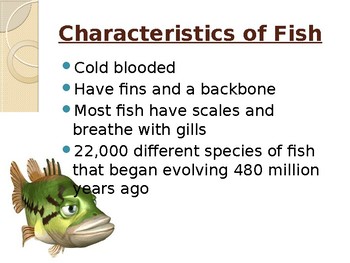
Fish Dissection Guide
Dissecting a fish is a great way to teach your students about body systems! Students can explore the respiratory system by examining the structure and function of gills. This complete dissection guide (45 slides!!) will lead your students through the step-by-step process of dissecting a fish AND teach them about the structure and function of each fish organ.
Three options:
(1) Display this presentation on your board and lead your students step-by-step.
(2) Give your students this dissection
Subjects:
Grades:
6th - 12th
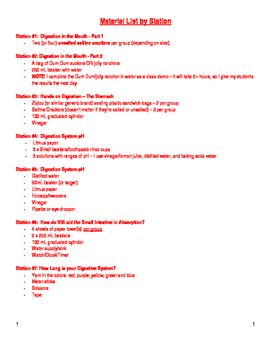
Digestive System Station Lab
This is a digestion system lab I created consisting of seven different stations. Students travel in pairs of small groups (I would suggest no larger than 4) to each of the labs where they are able to examine different components of the digestive system, including:
- How amylase (and enzymes in general) work
- How substrates and enzymes are specific on one another
- How the muscles of the stomach work to breakdown food
- What chemicals are found in the food that assist in digestion
- How pH
Subjects:
Grades:
7th - 12th
Showing 1-24 of 417 results



